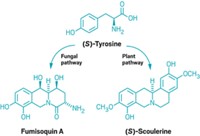Advertisement
Grab your lab coat. Let's get started
Welcome!
Welcome!
Create an account below to get 6 C&EN articles per month, receive newsletters and more - all free.
It seems this is your first time logging in online. Please enter the following information to continue.
As an ACS member you automatically get access to this site. All we need is few more details to create your reading experience.
Not you? Sign in with a different account.
Not you? Sign in with a different account.
ERROR 1
ERROR 1
ERROR 2
ERROR 2
ERROR 2
ERROR 2
ERROR 2
Password and Confirm password must match.
If you have an ACS member number, please enter it here so we can link this account to your membership. (optional)
ERROR 2
ACS values your privacy. By submitting your information, you are gaining access to C&EN and subscribing to our weekly newsletter. We use the information you provide to make your reading experience better, and we will never sell your data to third party members.
Environment
Tramadol Is Contaminant, Not Natural Product
Environmental Chemistry: Study confirms that opiate found in environment is synthetic
by Elizabeth K. Wilson
November 9, 2015
| A version of this story appeared in
Volume 93, Issue 44
A study confirms that the opiate tramadol recently found in trees is not a natural product, as controversially suggested in the past, but is instead human contamination (Angew. Chem. Int. Ed. 2015, DOI: 10.1002/anie.201508646). Chemists were surprised by the discovery of tramadol, which is a synthetic compound, in Sarcocephalus latifolius, a tree native to Cameroon and neighboring countries. The results suggested that tramadol might be a newly discovered natural product and added to the list of opiates produced by plants (Angew. Chem. Int. Ed. 2013, DOI: 10.1002/anie.201305697). However, Michael Spiteller of the Technical University of Dortmund and colleagues argued that farmers, who feed tramadol to cattle to help them tolerate extreme heat, released the compound into the environment (Angew. Chem. Int. Ed. 2014, DOI: 10.1002/anie.201406639). Now, Spiteller’s team reports the final nail in the coffin: The tramadol molecules from environmental samples contain no 14C. The abundance of 14C and other isotopes in molecules produced by living plants should match that of Earth’s atmosphere. The complete absence of 14C proves that the molecules are synthetic, the authors say.




Join the conversation
Contact the reporter
Submit a Letter to the Editor for publication
Engage with us on Twitter